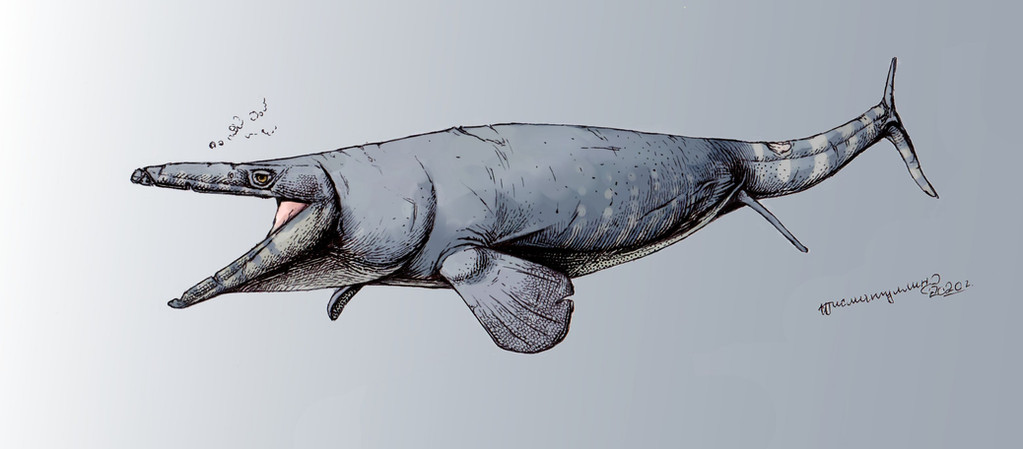HOME | DD
 Xiphactinus — Tylosaurus pembinensis
Xiphactinus — Tylosaurus pembinensis

#platecarpus #tylosauruspembinensis #monitorlizard #mosasaur #seareptiles #tylosaurus #mosasaurus #xiphactinusart
Published: 2020-02-02 15:25:16 +0000 UTC; Views: 11528; Favourites: 375; Downloads: 28
Redirect to original
Description
One of the groups of Mesozoic sauropsids that I have not illustrated much is the sea lizards mosasaurs. This is a fairly diverse and very interesting clade, and I felt I should have paid more attention to it. So this is a reconstruction of the large mosasaur Tylosaurus pembinensis from the late Cretaceous of Canada.
Tylosaurus is a genus of large mosasaurs from the Tylosaurinae subfamily, typical of the Santonian-Campanian stages of the United States, Canada, and Europe. Previously, it included many species, but now only a few are recognized. Among them is Tylosaurus pembinensis. Its holotype is a MT-2 specimen, nicknamed "Bruce". This taxon was at one time assigned to the Hainosaurus genus, which is characterized by a larger number of vertebrae, but as it turned out, Bruce's vertebrae belonged to two different individuals, and the species was assigned to Tylosaurus. The length of the Bruce is 12.8 m, which is quite impressive.
Overall, Tylosaurus was a fairly agile swimmer, more agile than the famous Mosasaurus hoffmanni. Significant amount of cartilage in the fins increased their flexibility, which also contributed to mobility. The spongy structure of the bones indicates a strong impregnation with fat, which increased buoyancy and reduced weight. A particularly important role in swimming was played by the fish-type caudal fin, known from prints in Platecarpus tympaniticus and present in many other mosasaurs. The structure of the Tylosaurus's skull allowed for considerable mobility, which reduced mechanical strength, but allowed it to swallow large chunks of meat. The teeth are quite massive for lightweight jaws. A distinctive feature of Tylosaurus (and its relatives, too) is the toothless tip of the premaxilla - a rostrum. It was used to ram prey to stun and even kill it. Frequent damage to the rostrum suggests that this mosasaur was capable of ramming very large prey. Today, orcas use the same method. The stomach contents of various specimens show an opportunistic feeding pattern: the prey of Tylosaurus was quite diverse.
This reconstruction is based on the work of Scott Hartman: images.squarespace-cdn.com/con… In the process, I tried to rely on known data about soft tissues. So, the tail has a characteristic fin, and the body is covered with small scales (too small to draw each scale separately). The teeth are covered with extraoral tissues, as in modern relatives. The number of skin folds is very limited to increase the body's flowability. The color in general shows an countershading pattern characteristic of many marine animals. Finally, you can notice numerous injuries in my Tylosaurus. Known data indicate a very aggressive lifestyle of large mosasaurs, including this taxon. Here I showed multiple scars from inter-and intraspecific interactions (including a damaged snout and a shark bite mark on the tail). I decided to add a gradient to the colored version. The result was, in general, very good and I'm really happy with it.
Black ballpoint and gel ink pens, whitewash and digital colouring in Krita, 2020.
Related content
Comments: 16

👍: 0 ⏩: 0

👍: 1 ⏩: 0

I just love how you add all of these little details like scales and wrinkles and scars which is really hard for me to draw...
👍: 0 ⏩: 0

Good morning, Tylosaurus pembinensis look great!!!!!!!.
👍: 0 ⏩: 0

Thanks! It's not dinosaur, though.
👍: 1 ⏩: 1

Oh sorry. :/ what is it?
👍: 0 ⏩: 1

It's a Mosasaur, a type of marine reptile more closely related to varanids and snakes of today...
👍: 0 ⏩: 1

👍: 0 ⏩: 1

👍: 0 ⏩: 0

👍: 0 ⏩: 0






























